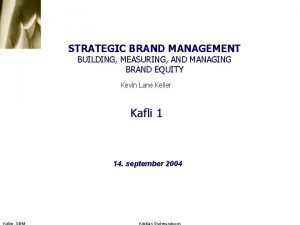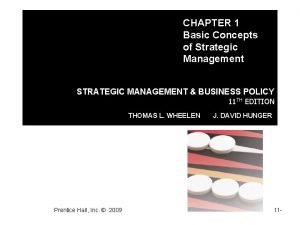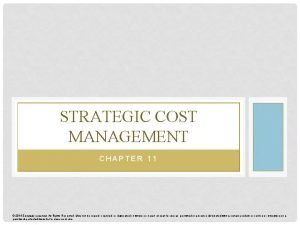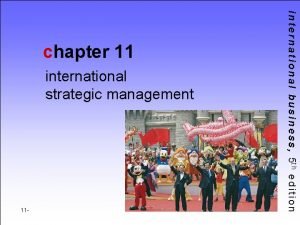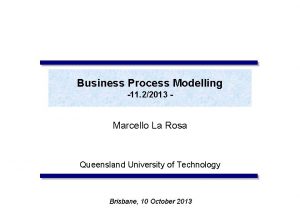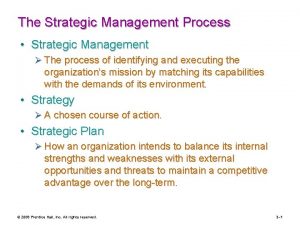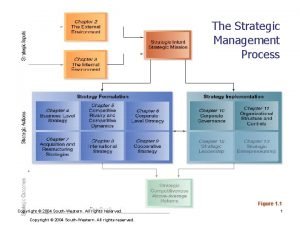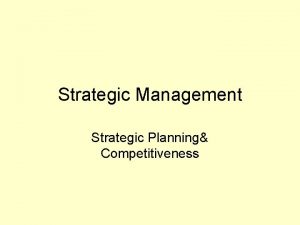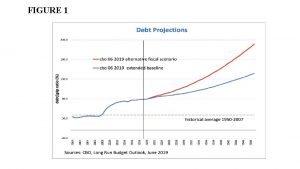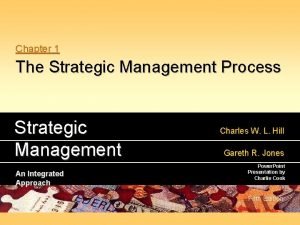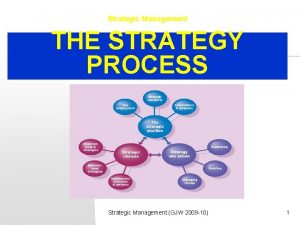The Strategic Management Process Figure 1 1 Copyright












































- Slides: 44

The Strategic Management Process Figure 1. 1 Copyright © 2004 South-Western. All rights reserved. 3

Business-Level Strategy (Defined) • An integrated and coordinated set of commitments and actions the firm uses to gain a competitive advantage by exploiting core competencies in specific product markets Copyright © 2004 South-Western. All rights reserved. 4

Business-Level Strategy Key Issues Which good or service to provide Business-level Strategy How to manufacture it How to distribute it Copyright © 2004 South-Western. All rights reserved. 5

Core Competencies and Strategy Core Competencies Resources and superior capabilities that are sources of competitive advantage over a firm’s rivals Strategy An integrated and coordinated set of actions taken to exploit core competencies and gain competitive advantage Business-level Strategy Providing value to customers and gaining competitive advantage by exploiting core competencies in individual product markets Copyright © 2004 South-Western. All rights reserved. 6

Customers: Business-Level Strategic Issues • Customers are the foundation of successful business-level strategy Ø Who will be served by the strategy? Ø What needs those target customers have that the strategy will satisfy? Ø How those needs will be satisfied by the strategy? Copyright © 2004 South-Western. All rights reserved. 7

Customer Needs—Who? Determining the Customers to Serve Consumer Markets Customers Industrial Markets Market Segmentation Copyright © 2004 South-Western. All rights reserved. 9

Basis for Customer Segmentation Consumer Markets 1. Demographic factors (age, income, sex, etc. ) 2. Socioeconomic factors (social class, stage in the family life cycle) 3. Geographic factors (cultural, regional, and national differences) 4. Psychological factors (lifestyle, personality traits) 5. Consumption patterns (heavy, moderate, and light users) 6. Perceptual factors (benefit segmentation, perceptual mapping) Table 4. 1 Copyright © 2004 South-Western. All rights reserved. SOURCE: Adapted from S. C. Jain, 2000, Marketing Planning and Strategy, Cincinnati: South-Western College Publishing, 120. 10

Basis for Customer Segmentation (cont’d) Industrial Markets 1. End-use segments (identified by SIC code) 2. Product segments (based on technological differences or production economics) 3. Geographic segments (defined by boundaries between countries or by regional differences within them) 4. Common buying factor segments (cut across product market and geographic segments) 5. Customer size segments Table 4. 1 Copyright © 2004 South-Western. All rights reserved. SOURCE: Adapted from S. C. Jain, 2000, Marketing Planning and Strategy, Cincinnati: South-Western College Publishing, 120. 11

Customer Needs—What? • Customer Needs to Satisfy Ø Customer needs are related to a product’s benefits and features Ø Customer needs are neither right nor wrong, good nor bad Ø Customer needs represent desires in terms of features and performance capabilities Copyright © 2004 South-Western. All rights reserved. 14

Customer Needs—How? • Determining the Core Competencies Necessary to Satisfy Customer Needs ØFirms use core competencies to implement value creating strategies that satisfy customers’ needs Ø Only firms with capacity to continuously improve, innovate and upgrade their competencies can expect to meet and/or exceed customer expectations across time Copyright © 2004 South-Western. All rights reserved. 15

Types of Business-Level Strategy • Business-Level Strategies Ø Are intended to create differences between the firm’s position relative to those of its rivals • To position itself, the firm must decide whether it intends to: ØPerform activities differently or ØPerform different activities as compared to its rivals Copyright © 2004 South-Western. All rights reserved. 16

Types of Potential Competitive Advantage • Achieving lower overall costs than rivals Ø Performing activities differently (cheaper process) • Possessing the capability to differentiate the firm’s product or service and command a premium price Ø Performing different (valuable) activities Copyright © 2004 South-Western. All rights reserved. 17

Two Targets of Competitive Scope • Broad Scope Ø The firm competes in many customer segments • Narrow Scope Ø The firm selects a segment or group of segments in the industry and tailors its strategy to serving them at the exclusion of others Copyright © 2004 South-Western. All rights reserved. 18

Five Business. Level Strategies SOURCE: Adapted with the permission of The Free Press, an imprint of Simon & Schuster Adult Publishing Group, from Competitive Advantage: Creating and Sustaining Superior Performance, by Michael E. Porter, 12. Copyright © 1985, 1998 by Michael E. Porter. Figure 4. 1 Copyright © 2004 South-Western. All rights reserved. 20

Cost Leadership Strategy • An integrated set of actions taken to produce goods or services with features that are acceptable to customers at the lowest cost, relative to that of competitors with features that are acceptable to customers ØRelatively standardized products ØFeatures acceptable to many customers ØLowest competitive price Copyright © 2004 South-Western. All rights reserved. 21

Cost Leadership Strategy • Cost saving actions required by this strategy: Ø Tightly controlling production costs and overhead Ø Minimizing costs of sales, R&D and service Ø Building efficient manufacturing facilities Ø Monitoring costs of activities provided by outsiders ØSimplifying production processes Copyright © 2004 South-Western. All rights reserved. 22

How to Obtain a Cost Advantage Determine and control Reconfigure, if needed Cost Drivers Value Chain § Alter production process § Change in automation § New distribution channel § New advertising media § Direct sales in place of indirect sales Copyright © 2004 South-Western. All rights reserved. § New raw material § Forward integration § Backward integration § Change location relative to suppliers or buyers 23

Examples of Value. Creating Activities Associated with the Cost Leadership Strategy SOURCE: Adapted with the permission of The Free Press, an imprint of Simon & Schuster Adult Publishing Group, from Competitive Advantage: Creating and Sustaining Superior Performance, by Michael E. Porter, 47. Copyright © 1985, 1998 by Michael E. Porter. Copyright © 2004 South-Western. All rights reserved. Figure 4. 2 24

Cost Leadership Strategy: New Entrants The Threat of Potential Entrants • Can frighten off new entrants due to: Ø Their need to enter on a large scale in order to be cost competitive Ø The time it takes to move down the learning curve Copyright © 2004 South-Western. All rights reserved. 26

Cost Leadership Strategy: Suppliers Bargaining Power of Suppliers • Can mitigate suppliers’ power by: Ø Being able to absorb cost increases due to low cost position Ø Being able to make very large purchases, reducing chance of supplier using power Copyright © 2004 South-Western. All rights reserved. 27

Cost Leadership Strategy: Buyers Bargaining Power of Buyers • Can mitigate buyers’ power by: Ø Driving prices far below competitors, causing them to exit, thus shifting power with buyers back to the firm Copyright © 2004 South-Western. All rights reserved. 28

Cost Leadership Strategy: Substitutes Product Substitutes • Cost leader is well positioned to: Ø Make investments to be first to create substitutes Ø Buy patents developed by potential substitutes Ø Lower prices in order to maintain value position Copyright © 2004 South-Western. All rights reserved. 29

Cost Leadership Strategy: Competitors Rivalry with Existing Competitors • Due to cost leader’s advantageous position: Ø Rivals hesitate to compete on basis of price Ø Lack of price competition leads to greater profits Copyright © 2004 South-Western. All rights reserved. 30

Cost Leadership Strategy (cont’d) • Competitive Risks Ø Processes used to produce and distribute good or service may become obsolete due to competitors’ innovations Ø Focus on cost reductions may occur at expense of customers’ perceptions of differentiation Ø Competitors, using their own core competencies, may successfully imitate the cost leader’s strategy Copyright © 2004 South-Western. All rights reserved. 31

Differentiation Strategy • An integrated set of actions taken to produce goods or services (at an acceptable cost) that customers perceive as being that are important to them different in ways Ø Nonstandardized products Ø Customers value differentiated features more than they value low cost Copyright © 2004 South-Western. All rights reserved. 32

Elasticities of demand • By offering a differentiated product the producer seeks to make the elasticity of demand for the product ’sticky’ or what we call inelastic. • If the demand for a product is inelastic it is not very sensitive to changes in price neither in changes in price of the product itself or the changes in price of subsitude products. Copyright © 2004 South-Western. All rights reserved. 33

Segmentation • Underlying differentiation is the concept of market segmentation – the identification of special groups of buyers who will pay more for a differentiated product that is targeted at them. A strong brand can even be a source of differentiation (Hilton), as well as levels of service (Ritz), better performance (Porsche) or design (Apple). Copyright © 2004 South-Western. All rights reserved. 34

The source of differentiation is important • First we must establish where the firm has potential for differentiation or can do so at a lower cost than rivals. The differentiation must be based upon the firm’s internal strengths in terms of resources and capabilities. • The more differentiation is based upon resources and capabilities which are specific to the firm or involve the complex coordination of large numbers of individuals, the more difficult it will be for competitors to imitate. Offering more leg room or wider seats can easily be imitated by another airline, high level of punctuality cannot. Copyright © 2004 South-Western. All rights reserved. 35

How to Obtain a Differentiation Advantage Control if needed Cost Drivers Reconfigure to maximize Value Chain § Lower buyers’ costs § Raise performance of product or service § Create sustainability through: § Customer perceptions of uniqueness § Customer reluctance to switch to nonunique product or service Copyright © 2004 South-Western. All rights reserved. 36

Examples of Value. Creating Activities Associated with the Differentiation Strategy SOURCE: Adapted with the permission of The Free Press, an imprint of Simon & Schuster Adult Publishing Group, from Competitive Advantage: Creating and Sustaining Superior Performance, by Michael E. Porter, 47. Copyright © 1985, 1998 by Michael E. Porter. Copyright © 2004 South-Western. All rights reserved. Figure 4. 3 38

Differentiation Strategy: New Entrants The Threat of Potential Entrants • Can defend against new entrants because: Ø New products must surpass existing products Ø New products must be at least equal to performance of proven products Copyright © 2004 South-Western. All rights reserved. 39

Differentiation Strategy: Suppliers Bargaining Power of Suppliers • Can mitigate suppliers’ power by: Ø Absorbing price increases due to higher margins Ø Passing along higher supplier prices because buyers are loyal to differentiated brand Copyright © 2004 South-Western. All rights reserved. 40

Differentiation Strategy: Buyers Bargaining Power of Buyers Copyright © 2004 South-Western. All rights reserved. • Can mitigate buyers’ power because well differentiated products reduce customer sensitivity to price increases 41

Differentiation Strategy: Substitutes Product Substitutes • Well positioned relative to substitutes because ØBrand loyalty to a differentiated product tends to reduce customers’ testing of new products or switching brands Copyright © 2004 South-Western. All rights reserved. 42

Differentiation Strategy: Competitors Rivalry with Existing Competitors Copyright © 2004 South-Western. All rights reserved. • Defends against competitors because brand loyalty to differentiated product offsets price competition 43

Competitive Risks of Differentiation • The price differential between the differentiator’s product and the cost leader’s product becomes too large • Differentiation ceases to provide value for which customers are willing to pay • Experience narrows customers’ perceptions of the value of differentiated features • Counterfeit goods replicate differentiated features of the firm’s products Copyright © 2004 South-Western. All rights reserved. 44

Criticism of the concept Differentiation: • Some forms of differentiation are not based on price: the option is therefore oversimplistic The form of differentiation may not lend itself to higher prices. • The firm may have as an objective to increase its market share, and it may use differentiation and low price for this purpose. Copyright © 2004 South-Western. All rights reserved. 45

Hard difference. . . • Identifying the need for differentiation solves nothing: it is the precise form, i. e. what will be attractive to the buyer is what matters, and is not easy to determine. So the real problem remains: how to make the product attractive to the customer. • It is easy to say: offer a product which is somehow different from the products which your competitors are offering, but finding a way to do that and succeeding in making the buyers appreciate the difference is hard. Copyright © 2004 South-Western. All rights reserved. 46

Focus Strategies • An integrated set of actions taken to produce goods or services that serve the needs of a particular competitive segment Ø Particular buyer group (e. g. youths or senior citizens Ø Different segment of a product line (e. g. professional craftsmen versus do-it-yourselfers Ø Different geographic markets (e. g. East coast versus West coast) Copyright © 2004 South-Western. All rights reserved. 47

Focus Strategies (cont’d) • Types of focused strategies ØFocused cost leadership strategy ØFocused differentiation strategy • To implement a focus strategy, firms must be able to: Ø Complete various primary and support activities in a competitively superior manner, in order to develop and sustain a competitive advantage and earn above-average returns Copyright © 2004 South-Western. All rights reserved. 48

Factors That Drive Focused Strategies • Large firms may overlook small niches. • A firm may lack the resources needed to compete in the broader market • A firm is able to serve a narrow market segment more effectively than can its larger industry-wide competitors • Focusing allows the firm to direct its resources to certain value chain activities to build competitive advantage Copyright © 2004 South-Western. All rights reserved. 49

Competitive Risks of Focus Strategies • A focusing firm may be “outfocused” by its competitors • A large competitor may set its sights on a firm’s niche market • Customer preferences in niche market may change to more closely resemble those of the broader market Copyright © 2004 South-Western. All rights reserved. 50

Integrated Cost Leadership/ Differentiation Strategy • A firm that successfully uses an integrated cost leadership/differentiation strategy should be in a better position to: Ø Adapt quickly to environmental changes Ø Learn new skills and technologies more quickly Ø Effectively leverage its core competencies while competing against its rivals Copyright © 2004 South-Western. All rights reserved. 51

Risks of the Integrated Cost Leadership/ Differentiation Strategy • Often involves compromises ØBecoming neither the lowest cost nor the most differentiated firm • Becoming “stuck in the middle” Ø Lacking the strong commitment and expertise that accompanies firms following either a cost leadership or a differentiated strategy Copyright © 2004 South-Western. All rights reserved. 56
 Resource based model
Resource based model Cultural aspects of strategy choice
Cultural aspects of strategy choice Strategic brand management process steps
Strategic brand management process steps Strategic management process
Strategic management process Strategic management decision making process
Strategic management decision making process Chapter 11 strategic cost management
Chapter 11 strategic cost management International strategic management process
International strategic management process Strategic fit vs strategic intent
Strategic fit vs strategic intent Strategic substitutes and strategic complements
Strategic substitutes and strategic complements Process hierarchy in process management
Process hierarchy in process management Hát kết hợp bộ gõ cơ thể
Hát kết hợp bộ gõ cơ thể Bổ thể
Bổ thể Tỉ lệ cơ thể trẻ em
Tỉ lệ cơ thể trẻ em Voi kéo gỗ như thế nào
Voi kéo gỗ như thế nào Glasgow thang điểm
Glasgow thang điểm Alleluia hat len nguoi oi
Alleluia hat len nguoi oi Môn thể thao bắt đầu bằng từ chạy
Môn thể thao bắt đầu bằng từ chạy Thế nào là hệ số cao nhất
Thế nào là hệ số cao nhất Các châu lục và đại dương trên thế giới
Các châu lục và đại dương trên thế giới Cong thức tính động năng
Cong thức tính động năng Trời xanh đây là của chúng ta thể thơ
Trời xanh đây là của chúng ta thể thơ Mật thư tọa độ 5x5
Mật thư tọa độ 5x5 Làm thế nào để 102-1=99
Làm thế nào để 102-1=99 Phản ứng thế ankan
Phản ứng thế ankan Các châu lục và đại dương trên thế giới
Các châu lục và đại dương trên thế giới Thơ thất ngôn tứ tuyệt đường luật
Thơ thất ngôn tứ tuyệt đường luật Quá trình desamine hóa có thể tạo ra
Quá trình desamine hóa có thể tạo ra Một số thể thơ truyền thống
Một số thể thơ truyền thống Cái miệng nó xinh thế
Cái miệng nó xinh thế Vẽ hình chiếu vuông góc của vật thể sau
Vẽ hình chiếu vuông góc của vật thể sau Thế nào là sự mỏi cơ
Thế nào là sự mỏi cơ đặc điểm cơ thể của người tối cổ
đặc điểm cơ thể của người tối cổ Ví dụ về giọng cùng tên
Ví dụ về giọng cùng tên Vẽ hình chiếu đứng bằng cạnh của vật thể
Vẽ hình chiếu đứng bằng cạnh của vật thể Tia chieu sa te
Tia chieu sa te Thẻ vin
Thẻ vin đại từ thay thế
đại từ thay thế điện thế nghỉ
điện thế nghỉ Tư thế ngồi viết
Tư thế ngồi viết Diễn thế sinh thái là
Diễn thế sinh thái là Các loại đột biến cấu trúc nhiễm sắc thể
Các loại đột biến cấu trúc nhiễm sắc thể So nguyen to
So nguyen to Tư thế ngồi viết
Tư thế ngồi viết Lời thề hippocrates
Lời thề hippocrates


